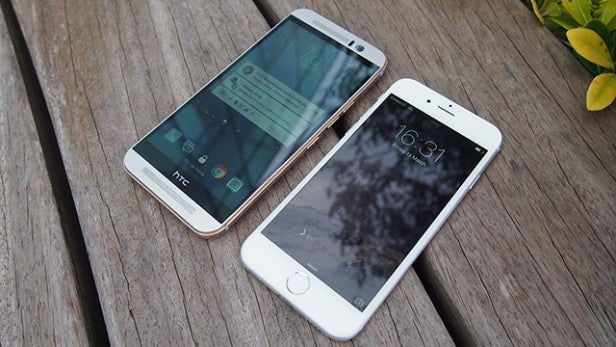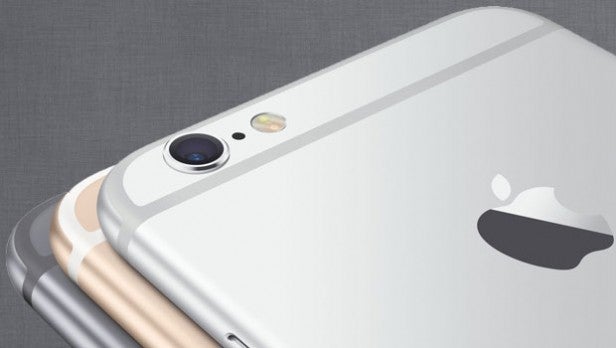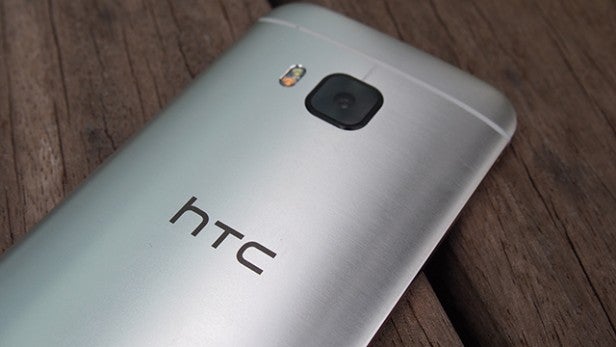HTC One M9 vs iPhone 6: Can HTC take on Apple?

iPhone 6 or HTC One M9? We compare the specs to find out which metal smartphone is the best
HTC’s Android king for 2015 is the HTC One M9 and it’s one of the best alternatives to the iPhone 6 if you’re after a new top-end phone. It didn’t impress us quite as much as the One M8 before it, but it’s still a great device.
Both are made of metal, both have serious 64-bit power and top-tier cameras. But which is right for you?
When looking at phones that are both pretty great, that’s not an easy question to answer. So we’ve broken it down into the elements, to let you decide what is more important for your needs.
HTC One M9 vs iPhone 6: Design
One M9: 9.5mm thick, aluminium casing
iPhone 6: 6.5mm thick, aluminium casing
These phones are some of 2015’s big supporters of metal designs. Both have shells made largely of aluminium, getting you a much fancier, harder feel than a plastic phone. It makes spending £500 or more on a phone a bit easier to live with.
Their styles are quite different, though. Where the iPhone 6 has smooth edges but a flat back, the HTC One M9’s back is all-curve. It’s a lot chunkier too at around 9.5mm thick to the iPhone’s 6.5mm, but feels great as the curve softens its shape hugely.
SEE ALSO: iPhone 6 vs iPhone 6 Plus
The HTC One M9 is a bit larger, though, as it fits speakers above and below the screen, not to mention having a screen 0.3 inches larger than the iPhone. Put a case on the HTC One M9 and it’ll get fairly big. The iPhone 6 suits a case perfectly, not least because aluminium back scratches fairly easily.
Apple’s phone also has a neat fingerprint scanner, which lives under the main Home button, but HTC has not followed suit. Its experiments with scanners in phones like the HTC One Max have not been successful to date, so we’re pretty happy with that decision. In the iPhone, the TouchID scanner can be used to authorise payments and unlock the phone.
HTC One M9 vs iPhone 6: Screen
One M9: 5-inch 1,920 x 1080 Super LCD screen
iPhone 6: 4.7-inch, 1,334 x 750 pixel IPS LCD
It took Apple ages to boost its phone screen size above four inches, and the iPhone 6 is still smaller than most top-end Androids. It has a 4.7-inch screen, while the HTC One M9 is a bit larger at five inches.
Neither is a giant when you look at what LG and Samsung’s top phones pack these days.
Resolution is a similar situation, too. Just as everyone else is packing Quad-HD screens into their phones, the HTC One M9 has a conservative 1080p screen while the iPhone 6 sits somewhere between 720p and Full HD. It uses an odd-sounding 1,334 x 750 display.
In day-to-day use though, you’ll struggle to notice a real difference between these displays. Text on a website or e-book was crisp, movies were vibrant and pixels almost impossible to spot. Colours ‘popped’ a little more on HTC’s panel, which is nice for scrolling through menus and playing games, but we often felt images weren’t quite as colour accurate as they should be. That’s just a small niggle though and one you probably wouldn’t even notice unless you were holding both the devices side-by-side.
SEE ALSO: Galaxy S6 vs iPhone 6

We did find the iPhone 6 has slightly better brightness plus a more accurate, and less jarring, auto-brightness setting. On the M9 it felt like the brightness took longer than it should to adjust, whereas the iPhone 6 would smoothly move up the levels. Again, this is small niggle, but it annoyed us on a number of occasions.
If there was a clear area in which one of these devices screen outperformed the other, it would be in viewing angles. The iPhone’s IPS LCD panel didn’t lose colour and turn into a shadowy mess anywhere near as quickly as the Super LCD3 version on the M9. iPhone’s have always had impressive viewing angles and that is continued with the latest iteration.
HTC One M9 vs iPhone 6: Storage
One M9: 32GB with microSD
iPhone 6: 16/64/128GB
The iPhone 6 was one of the first phones to come as a 128GB model. The premium involved just wouldn’t make sense with just about any other phone series, aside from Samsung’s Galaxy line.
Don’t have £700/$849 burning a hole in your pocket? You might also want to consider the lower-end 16GB and 64GB models instead. Apple used to make a 32GB iPhone, but that model has been nixed now that the big daddy 128GB version is here.
Saying that, we’d heavily advise against picking up the 16GB iPhone model. It’s just too small. Too limiting and while it might be lighter on your pocket initially, once you’ve downloaded a few apps and snapped a few pictures it will soon begin to fill up. App sizes should get smaller across the board with the introduction of iOS 9 later on in the year, but we don’t think it will be enough.
Frankly, we’re still a bit baffled as to why Apple didn’t ditch 16GB instead of 32GB, just like the competition seems to have done.
The HTC One M9 takes a much friendlier approach. There’s a microSD memory card slot, something we’ll never see on a mobile Apple product, tucked into a slot on the side. This will take 128GB cards, but the 32GB of memory you get as standard should be enough for most people. And with streaming and cloud storage services improving all the time, there’s much less of a dependance on having all your media stored on the phone itself.
We’re certainly impressed that HTC has managed to keep the microSD card slot though, especially as Samsung ditched expandable storage with its jump to a metal fuelled design.
HTC One M9 vs iPhone 6: Software
One M9: Android 5.0 Lollipop with HTC Sense 7
iPhone 6: iOS 8.4
Asking “Android or iOS?” used to be closely linked to how geeky you were, but these days Android is almost, if not more, slicker than iOS, and much less flaky. However, HTC complicates the issue a bit by using its own UI, called HTC Sense.
If you’ve used an HTC phone before you’ll find it pretty familiar, and it looks quite similar to the UI style of HTC phones of the last two years.
BlinkFeed is one of the ‘stars’ of the show. It’s a custom homescreen, replacing the Google Now pane you’d find on stock Android devices, that acts as a customisable feed of digital content. It’s a bit like a magazine for your phone, that’s populated with the latest bursts of news, updates from Facebook plus snaps from Instagram. It’s fairly pretty, smooth and gives you a nice overview of certain things that are going on, but it won’t replace dedicated apps and after the first few days we barely ever touched it again.
HTC has massively increased the customisation on offer too by packing themes into the latest version of Sense. They let you alter the lock screen, the fonts used, and provide a set of lock/home screen wallpapers. There’s no doubt that this theming engine is a nice touch and immensely powerful (you can take a photo and it’ll create an entire theme based the colours you captured) but you really have to delve deep to find anything that makes the interface look slicker than HTC’s implementation.
SEE ALSO: Android M vs iOS 9 – which should you be more excited about?
You can’t really do any of this in iOS, aside from changing wallpapers. Contrary to some expectations, Apple has never added Android-style widgets to iOS. Just ‘Extensions’ that sit in the Notification Centre. But, if you’re heavily tied in to the Apple ecosystem there’s plenty about iOS that will probably making it the best pick for you. From iMessage to FaceTime, Continuity with OS X Yosemite to iCloud, Apple devices work best when you have lots of them.
iOS 9 is bringing some nice tweaks too. Like an overhauled Notes app, transit direction in Maps and a Google Now inspired Siri update that’ll show you useful information depending on what you’re doing. Android will also get an update this year, probably about the same time as iOS hits, in the form of Android M. This brings some nifty battery saving improvements, the awesome looking Google Now on Tap and support for Android Pay. But, we wouldn’t expect this to hit the HTC One M9 until the very end of the year if not into 2016.
HTC One M9 vs iPhone 6: CPU and Power
One M9: 64-bit Snapdragon 810 octo-core with 3GB RAM
iPhone 6: 64-bit Apple A8 CPU with 1GB RAM
iPhones used to get ribbed for just nicking tech innovations from elsewhere, but iPhones were actually among the very first 64-bit phones. The iPhone 6 uses an Apple A8 processor, a very impressive dual-core CPU partnered with a quad-core GPU.

It’s powerful, but sounds a bit weak next to the eight-core Snapdragon 810 of the HTC One M9. It has four 2GHz Cortex-A57 power cores and four 1.5GHz Cortex-A53 efficiency cores. Eight versus two can’t be fair can it?
They’re all based on the ARMv8 architecture and are 64-bit, but the HTC One M9 is certainly not four times faster. Let’s look at their Geekbench 3 results: the iPhone 6 scores around 2850-2900 points while the HTC One M9 will be able to score 3900-4000. In real use, both phones are snappy and make ease of the majority of tasks. We encountered almost no slow-down using either devices, they’re both fantastic performers. And that’s pretty much what we’d expect, especially as the HTC One M9 doesn’t have a super high-res display to power.
The HTC One M9 has significantly more RAM, though. It has 3GB while the iPhone 6 has 1GB. It’s all down to how well-tailored their operating systems are, but we have started to feel that iOS is held back by this lack of RAM. Apps close often and web pages always have to be reloaded, but it’s fine for 90% of things you’re likely to do. We definitely wouldn’t avoid the iPhone due to this lack of RAM.
HTC One M9 vs iPhone 6: Camera
One M9: 20-megapixel rear camera, 4-megapixel front camera, dual-LED flash
iPhone 6: 8-megapixel rear camera, 1.2-megapixel front camera, dual-LED flash
Last year’s top HTC phone, the HTC One M8, actually had a lower-res main camera than the last iPhone. There’s been a big role reversal this time, though.
The HTC One M9 has a very high-res 20-megapixel main sensor, with reams more pixels than the 8-megapixel iPhone 6. HTC’s latest uses a Toshiba sensor, rather than the Sony model we often see in phones – including the iPhone.
While using both these phones we’ve finally been able to put to bed the old megapixel debate. Having a bigger number of megapixels does not make for a better smartphone camera. The iPhone 6 beats the HTC One M9 in almost every single area – it takes sharper, more accurate pictures that look far more true to life in each situation we tried.

Yes, if you’re in perfect light then you can get a decent picture with the One M9. And because of all the megapixels you can zoom in much further without the image turning into a grainy mess. But, the end results just lacks all the vibrancy, colour and oomph that we managed to achieve when shooting with the iPhone 6. The snapper on Apple’s flagship is also much faster. Whether it’s the app opening, focusing or taking the actual picture.
We were also a little disappointed with HTC’s effort when it came to shooting video. Even though it can effectively shoot 4K footage, we’d thoroughly suggest giving it a miss. That is unless you’re happy with video, that while is a high-resolution, is stuttery, badly over-exposed and prone to randomly lose focus. The iPhone can only manage 1080p footage, but it shoots at 60fps and looks much better. The addition of fun slow-mo modes are also a plus, especially as you easily shoot super slow-mo 240 fps video.
SEE ALSO: Smartphone camera tech you should get excited about
To give HTC its due, the front camera is certainly kind of exciting and outperforms the iPhone version. It uses the 4-megapixel UltraPixel sensor we saw on the back of last year’s One M8.
It’s one of the most advanced selfie cameras we’ve seen, although not one of the highest-res. The HTC Desire Eye has a 13-megapixel front camera, for example. However, this one has much larger sensor pixels and takes some very impressive nighttime selfies. You’re not, well we hope you’re not, going to base your phone buying on the strength of the front-facing camera.
Both phones have a smart two-tone flash on the back. The idea is that the tone of the flash won’t be plain white, to avoid washing-out people’s faces and skewing the look of scenes too much. This was something Apple came up with before HTC, having surfaced in the iPhone 5S back in 2013.
HTC One M9 vs iPhone 6: Battery
One M9: 2840mAh
iPhone 6: 1810mAh
The iPhone 6 battery looks pretty puny up against the HTC One M9. It has an 1810mAh battery, the HTC has a 2840mAh one. iOS is a bit more efficient than Android, but we do find that top Android devices like the One M9 last a good bit longer than the iPhone 6, which isn’t too hard to drain down in a day.
Neither has any fancy tech tucked under the hood like Qi wireless charging, but HTC’s One M9 does have Qualcomm Quick Charge 2.0 – which takes you from 0% to about 50% in half an hour. It’s a nice touch, especially when you only have a few minutes before you need to pop out. The iPhone doesn’t have this, but because of the smaller battery we found the iPhone would juice up very quickly anyway.
During our time testing both these devices we’d tend to always charge them overnight. If we happened to leave them going throughout those nighttime hours, we’d be deeply in the red in the morning.
SEE ALSO: Smartphone battery comparison – who will come out on top?
HTC One M9 vs iPhone 6: Speaker
One M9: BoomSound stereo speakers with Dolby DSP
iPhone 6: Single-output speaker
One area where we’d be disappointed, and surprised, if HTC didn’t win out is speaker quality. HTC’s BoomSound speakers are still pretty much the best around. They take up a fair bit of space, but it’s well worth it.
They sit above and below the screen, giving you a good stereo image when the phone is held in front of your face to watch a film or a clip on YouTube. It makes the HTC One M9 taller than some others, but the sacrifice is well worth it if you care about sound quality.
In return you get a much beefier, more powerful sound than just about every other phone, including the iPhone 6. Apple’s latest has a nice clear, fairly loud speaker, but it just doesn’t have the mid-range and lower-end warmth and authority of the HTC One M9’s BoomSound pair. It also uses a single output on the bottom edge, so no stereo effect here.
Verdict: Which deserves your cash?
The iPhone 6 is more of a dynamic change for the series than the HTC One M9 is for HTC’s One series. However, there’s a lot to like about the new HTC model.
Its sleek metal design, the fantastic BoomSound speakers, Quick-Charge tech enabled battery, versatile storage and excellent power make it a great choice if you’re thinking of splitting away from the iPhone pack. But the middling camera and lack of real innovation make it tough to wholeheartedly recommend.
It’s even harder to recommend when it’s going head to head with one of the best phones Apple has ever produced.
We always found ourselves heading to the iPhone 6 first. We’d pull it out for browsing, using apps and most of all, snapping pictures. The rear camera on the iPhone 6 is fantastic and HTC really needs to improve its game in this area next year. Upping the megapixels but picking an inferior sensor and forgetting to optimise the app properly really haven’t worked.
In this particular battle we’d have to say the victor is Apple’s iPhone 6. Better luck next year, HTC.


